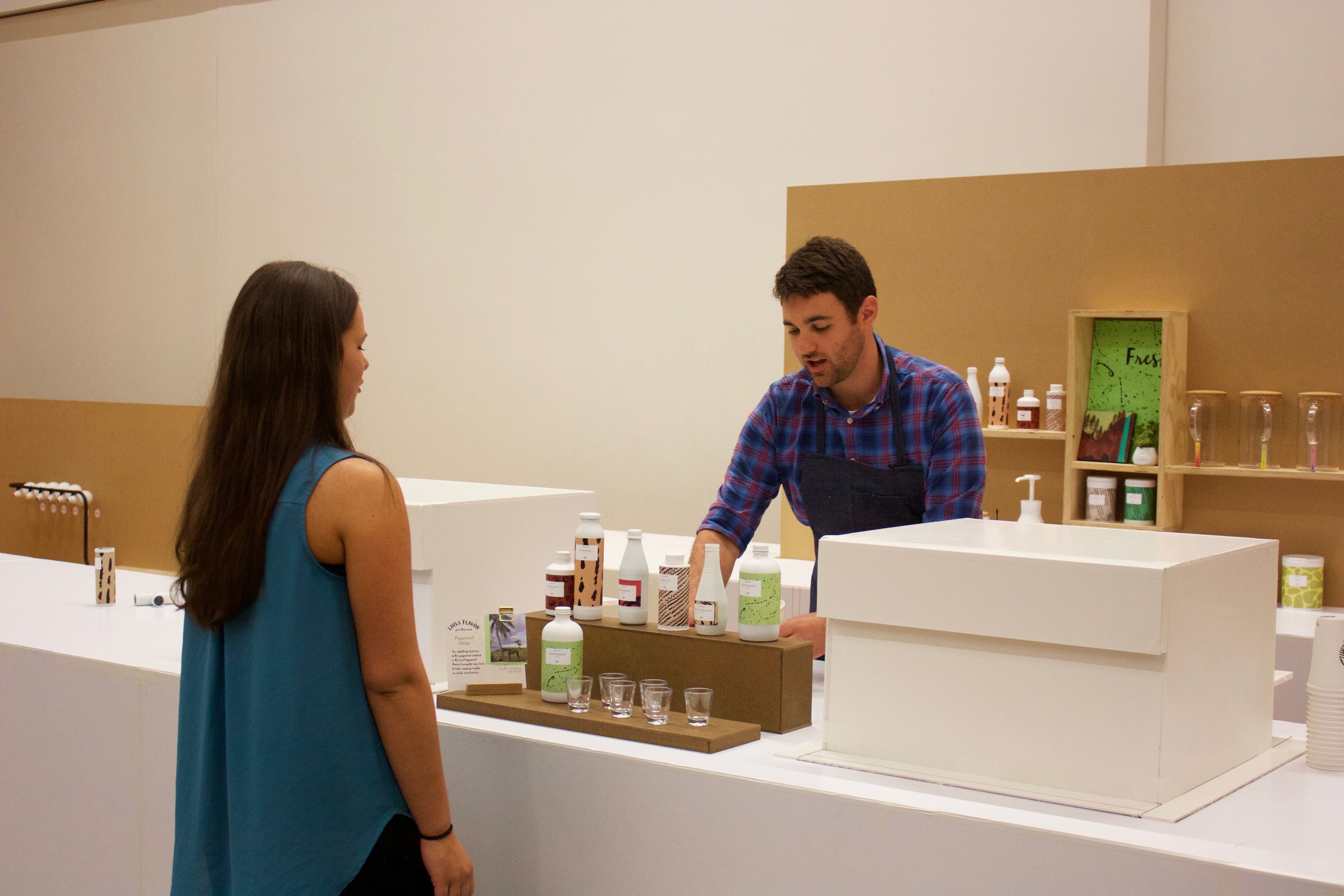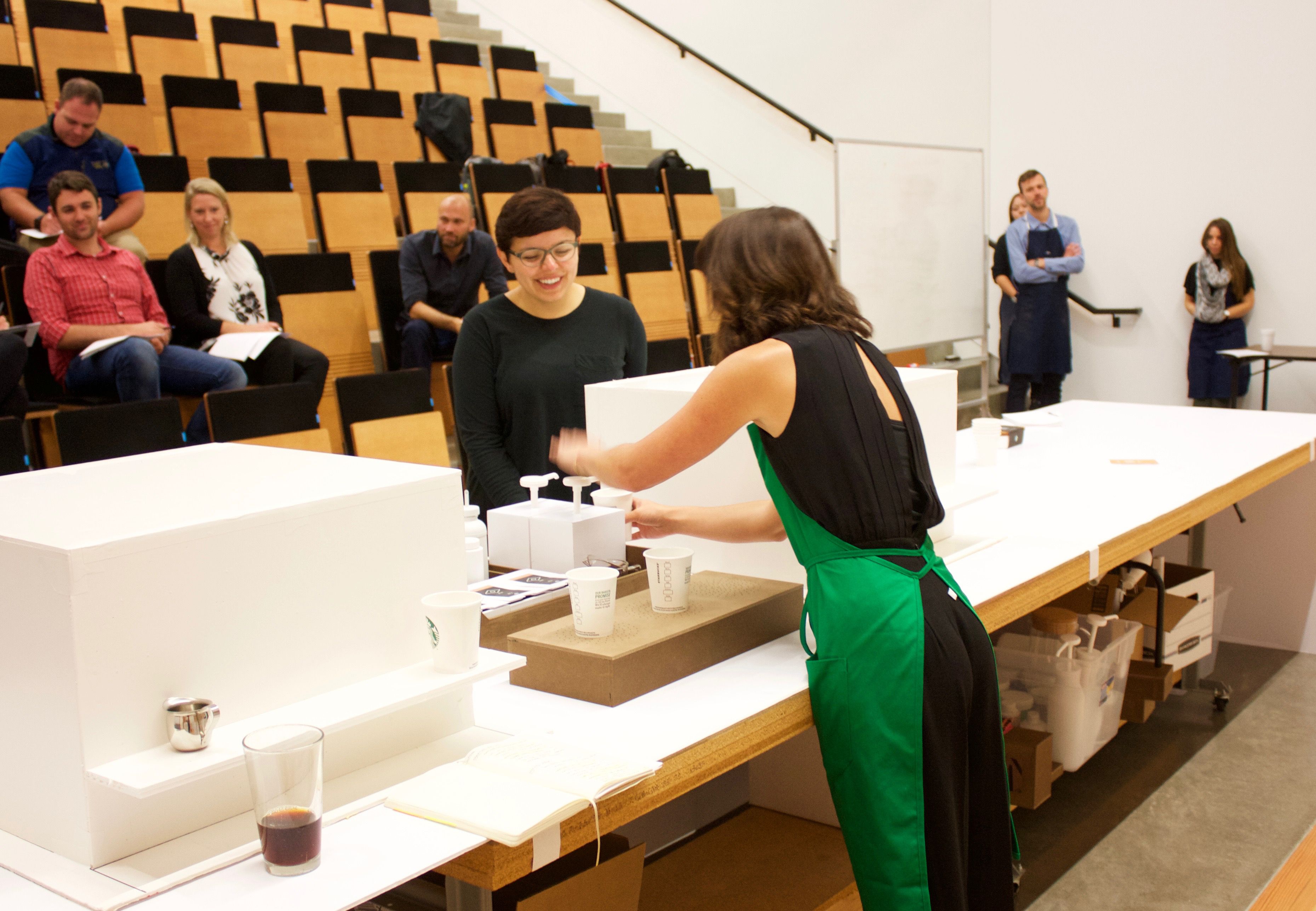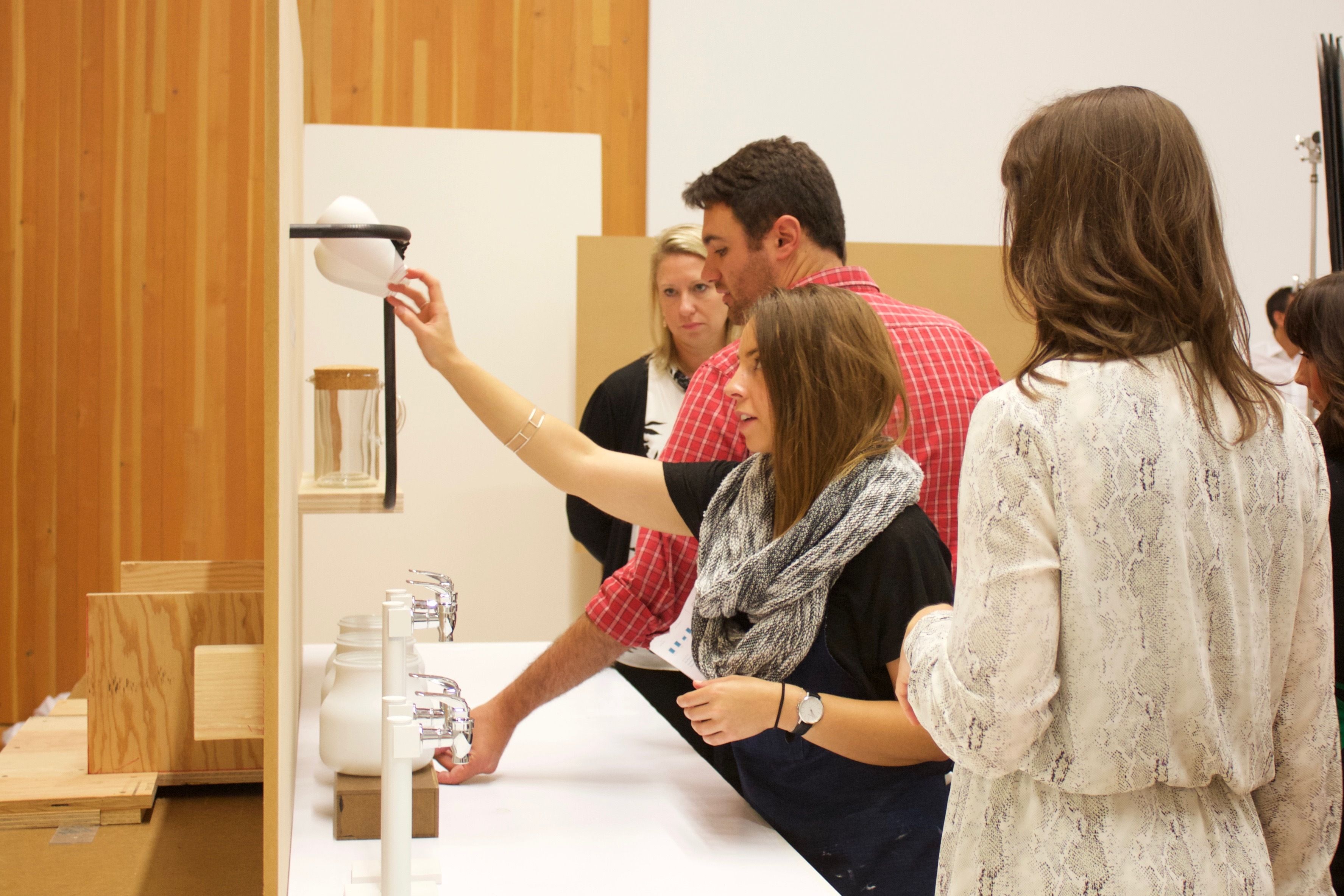Ziba’s auditorium has appeared over the years to be a forum for the kind of experimental theater that features actor and audience role improvisation and sets with makeshift props that are rearranged to suit emerging narratives. What has appeared on the stage is, in fact, experience prototyping in action, a multidisciplinary design method that to many in our technologically advanced age seems incongruously low fidelity. Yet it is both the unfinished quality of the “stage set” and the audience and designers engaged in improvisational role play that lend themselves to surprising discoveries very difficult to achieve with other design methods.
It is Ziba’s experience that-- to adapt an old aphorism, “if you build it, they will play.” The two client engagements detailed below demonstrate that some playful experimentation with physical and “phygital” prototypes is a uniquely effective way to uncover and envision customer experience innovations and de-risk proposed CX investments.
A Coffee Retailer Adapts Its CX Design to the Craft Spirits Movement
When a global leader in the coffee industry asked Ziba to suggest ways to enhance their customer experience (CX), there was little room for improvement of many of its experience features: convenience and consistency, offering variety, and the coffee brand’s smash hit revival of the cultural and countercultural role that coffee houses have filled through the ages.
There had appeared at the time, however, a countervailing trend in experiences and experience design. It eschewed convenience in favor of slowing down and sensuously savoring the expert, artful nature of handmade aspects of life. The craft beer and spirits movements were redefining watering holes across the nation, as well as living room bar carts and patio parties, in ways that recalled America’s speakeasies during Prohibition.
Ziba’s research and CX prototypes helped the coffee retailer grasp that it was in the midst of a contradiction: between the widespread convenience values of the marketplace and the showmanship and sociality of the craft spirits craze. Douglas Holt argues in How Brands Become Icons that brands should perform a myth “…that addresses an acute contradiction in society.” To explore this contradiction fully, Ziba conducted visits to other coffeehouses and bars, signed up for wine tastings, and studied the role of the barista and sommelier before designing and constructing three distinct experience prototypes—in just two weeks.
About thirty members of the client team participated in each, and, with prompting from designers, shared their feelings, observations and preferred CX prototype.
Given what the recent pandemic period taught companies about frontline workers’ invaluable operational insights, it was not surprising that the baristas’ prototype interactions revealed exciting design opportunities. Encouraged by Ziba researchers and designers to develop each prototype in any direction, from “mild to wild,” baristas improvised ways to mitigate the overly mechanized quality of fast coffee preparation and presentation. One prop, a Ziba-designed Lazy Susan, enabled the baristas to replace the current desultory practice of leaving orders on the counter with a more personalized interaction with the customer. With the beverage placed atop the pedestal and the customer’s name called, the barista would then wait until the customer could witness finishing touches of whipped cream or chocolate powder.
In response to customers’ and baristas’ observations about the bulky flavor pump bottles suggestive of mass production, Ziba fashioned a handsome countertop apparatus for flavor dosing with elegant bottles gently swinging back into place after use. The new piece of equipment would celebrate both the quality of the flavor additives and the barista’s skill in customizing each beverage. Moreover, observing this ritual moment, customers could be assured they would have their convenience and their craft too, thus securing the mythical role the coffee retailer plays in their lives. Shortly after the prototyping session, the coffee chain asked Ziba to build the flavor apparatus for trial in the market.
Eyewear Purveyor OPSM Uses CX Prototyping to Fend Off Low-Cost Competitors
OPSM is a leading international prescription eyewear retailer renowned for its eye care, due to its store-based optometrists and its advanced Acufit technology. Despite its deep designer offerings, the eyewear chain was not, however, perceived at one time to be the leader in frame style selection, a critical driver of consumers’ eyewear retailer choices. Lower cost competitors were proliferating, prompting OPSM to consider what role an enhanced customer experience might play in securing the chain’s reputation for both eye care and eyewear style. OPSM approached Ziba to find out.
Initial research revealed that copious and curated eyeglass styles were on display, and that the Acufit technology was impressively precise and helpful in decision-making about lens coatings, etc., but neither were meaningfully integrated into the customer experience. Employees’ rote responsibilities allowed little leeway for the kind of stylistic guidance that celebrates individual identity and personal choice. The environmental design and overall process still conjured a doctor’s office visit more than a styling salon.
These and other research findings were distilled into key insights and drivers during co-creative sessions at the OPSM offices involving a rudimentary CX prototype, storyboards, and sketches. Both teams sensed, however, that key customer moments and interactions still weren’t dimensionalized enough, that all the sensory, spatial, temporal, cognitive, emotional, and social elements and ephemera of a customer experience were impossible to imagine without further firsthand exploration. The next step: service, graphics, and environmental designers building a full CX prototype in the Ziba auditorium.
Consensus is great but strong conviction about new CX design decisions is better. As OPSM employees and customers explored the physical prototype, one such conviction was quickly formed around the “paradox of choice” impression created by too many eyeglass selections in front of the customer, as well as the proposed app-enabled solicitation of friends’ opinions. To declutter the experience and the customer’s mind, a new tray was envisioned as a focal point, its own spatial constraints encouraging a narrowing of choices. Once a final pair of eyeglasses was selected, the tray would be designed to be flipped over, revealing a leather surface with a custom slot for the eyeglasses’ prescription card. The overall impression? The world itself would appear more artfully designed once a customer had made a stylish eyewear choice.
Further decluttering of the junctures in the customer journey meant touchpoints were reduced from 18 to three. With less mess, and store signage that reinforced the personal style benefits of the right eyeglasses, the employees were now free to act as both stylist and “Acufitter.” Employee experience, as countless studies have shown, is critical to CX excellence, so OPSM would need an elevated, well-considered way for its employees to interact with customers and their store context. The mirrors consequently were outfitted with flattering lighting, and the service counters with gorgeous drawers for housing the stylists’ tools. Stylists would don aprons as customers approached for their final fitting, and, drawing from hair salon and barbershop customs, would be swiveled around to appreciate their newly bespectacled selves. A picture would be taken as memento.
You can read about OPSM’s successful new store prototype and its rollout here.
How CX Prototyping Unleashes the Power of Play and Empathy
These and other successful CX prototyping engagements confirm the values this design method provides that are irreplicable by any other approach. Some paper-based or data-derived ideas quickly fall flat in the prototyped world. Other ideas arise with clarion force in a physical prototype, as actors’ embodied experience in the make-believe space helps them draw inspiration from their entire realm of experiences. The complexity of human behavior requires nuanced, empathetic design interventions, and those are best achieved—indeed, in many cases, only achievable through firsthand, felt familiarity with the customer experience the company hopes to provide.
Here's a short list of CX prototyping benefits to share with your colleagues:
1. Greater team conviction and clarity about which ideas to reject and which to build
2. Deeper team members’ commitment to CX enhancements they had a hand in identifying
3. A wider range of CX design ideas engendered by the spirit of play that permeates CX prototyping exercises
4. Genuine customer empathy, which has been proven to be surest route to a company’s CX mandate
To learn how CX prototyping could benefit your business, and Ziba’s full range of prototyping services, reach out to:





